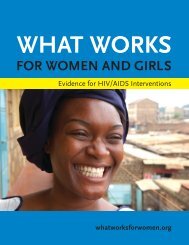Global Tuberculosis Report -- 2012.pdf
Global Tuberculosis Report -- 2012.pdf
Global Tuberculosis Report -- 2012.pdf
You also want an ePaper? Increase the reach of your titles
YUMPU automatically turns print PDFs into web optimized ePapers that Google loves.
CHAPTER 7Addressing the co-epidemicsof TB and HIVKEY FACTS AND MESSAGES In 2011, 1.1 million (13%) of the 8.7 million people whodeveloped TB worldwide were HIV-positive; 79% ofthese HIV-positive TB cases were in the African Region. WHO’s recommended package of collaborative TB/HIV activities to reduce the burden of TB/HIV includesHIV testing for TB patients; CPT and early initiation ofART for HIV-positive TB patients; and screening for TBamong people living with HIV and provision of IPT tothose eligible for it. Substantial progress in the implementation ofcollaborative TB/HIV activities has occurred since WHOrecommendations were fi rst issued in 2004, and furtherprogress was evident in 2011. The percentage of notifi ed TB patients with adocumented HIV test result in the African Region rosefrom 60% in 2010 to 69% in 2011; 46% of thosetested in 2011 were HIV-positive, ranging from 8% inEthiopia to 77% in Swaziland. Worldwide, 40% of TBpatients notifi ed in 2011 had a documented HIV testresult, up from 33% in 2010 and more than ten timesthe level of 2004. In 2011, 79% of TB patients known to be HIV-positive,were provided with CPT, and 48% were started onART, similar to levels achieved in 2010. More workremains to be done to ensure that all HIV-positive TBpatients are rapidly started on ART, in line with WHOrecommendations. Their progress on treatment shouldalso be closely monitored. In 2011, 3.2 million people enrolled in HIV care werereported to have been screened for TB, up 39% from2.3 million in 2010. Of those without active TB disease,0.45 million were provided with IPT, more than doublethe number started on IPT in 2010 (mostly the result ofprogress in South Africa). The scale-up of collaborative TB/HIV activities saved atotal of 1.3 million lives between 2005 and the end of2011.People living with HIV who are also infected with TB aremuch more likely to develop TB disease than those whoare HIV-negative. 1 Starting in the 1980s, the HIV epidemicled to a major upsurge in TB cases and TB mortality inmany countries, which persisted throughout the 1990sand up to around 2004, especially in southern and eastAfrica (Chapter 2, Chapter 3).In 2011, 1.1 million (13%) of the 8.7 million peoplewho developed TB worldwide were HIV-positive (Chapter2, Table 2.1); 79% of these HIV-positive TB cases werein the African Region. <strong>Global</strong>ly, there were an estimated0.4 million HIV-associated TB deaths in 2011, withapproximately equal numbers among men and women(see Chapter 2). WHO, UNAIDS and the Stop TB Partnershiphave set a target of halving TB mortality ratesamong people who are HIV-positive by 2015 comparedwith 2004 (the year in which TB mortality among HIVpositivepeople is estimated to have peaked). 2WHO recommendations on the interventions neededto prevent, diagnose and treat TB in people living withHIV have been available since 2004, 3,4 and are collectivelyknown as collaborative TB/HIV activities. They includetesting TB patients for HIV, providing antiretroviral therapy(ART) and co-trimoxazole preventive therapy (CPT)to TB patients living with HIV, providing HIV preventionservices for TB patients, intensifying TB case-findingamong people living with HIV, offering isoniazid preventivetherapy (IPT) to people living with HIV who do nothave active TB, and controlling the spread of TB infectionin health-care and congregate settings (the latter threeactivities are referred to as the “Three Is for HIV/TB”).Antiretroviral therapy significantly reduces the risk ofmorbidity and mortality from TB. A meta-analysis publishedin 2012 found that ART reduces the individual risk1The probability of developing TB among people living withHIV divided by the probability of developing TB among HIVnegativepeople is the incidence rate ratio (IRR). The medianvalue of the IRR in 155 countries for which data were availablein 2011 was 14 (inter-quartile range 12–20).2Getting to zero: 2011–2015 strategy. Geneva, Joint United NationsProgramme on HIV/AIDS, 2010.3Policy on collaborative TB/HIV activities. Geneva, World HealthOrganization, 2004 (WHO/HTM/TB/2004.330; WHO/HTM/HIV/2004.1).4WHO policy on collaborative TB/HIV activities: guidelines for nationalprogrammes and other stakeholders. Geneva, 2012 (WHO/HTM/TB/2012.1).74 GLOBAL TUBERCULOSIS REPORT 2012
















